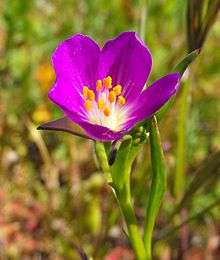Calandrinia ciliata
Calandrinia ciliata is a species of flowering plant known as fringed redmaids[1] and red-maids.[2] While formerly included in the purslane family,[3] it is now treated as a member of the family Montiaceae.[4]
| Calandrinia ciliata | |
|---|---|
 | |
| Scientific classification | |
| Kingdom: | Plantae |
| Clade: | Tracheophytes |
| Clade: | Angiosperms |
| Clade: | Eudicots |
| Order: | Caryophyllales |
| Family: | Montiaceae |
| Genus: | Calandrinia |
| Species: | C. ciliata |
| Binomial name | |
| Calandrinia ciliata (Ruiz & Pav.) DC. | |
| Synonyms | |
| |
It is native to western North America from British Columbia to New Mexico, where it is widespread and common. It can also be found in parts of Central and South America.
Description
Calandrinia ciliata is an annual herb which varies greatly in size from a small patch a few centimeters wide to an erect form approaching 40 cm (16 in) tall. The linear or lance-shaped leaves are 1 to 10 cm (0.39 to 3.94 in) long and slightly succulent in texture.
The inflorescence is a raceme bearing flowers on short pedicels. The flower has usually five deep pink to red petals, each up to 1.4 cm (0.55 in) in length. There are two sepals at the base beneath the petals.
This is a hardy plant well adapted to many habitat and climate types. Where it is an introduced species, it is known as a minor weed.[5]
References
- "Calandrinia ciliata". Natural Resources Conservation Service PLANTS Database. USDA. Retrieved 4 March 2016.
- "BSBI List 2007". Botanical Society of Britain and Ireland. Archived from the original (xls) on 2015-01-25. Retrieved 2014-10-17.
- "Calandrinia ciliata". ucjeps.berkeley.edu. Jepson eFlora. 1993. Retrieved 2018-10-31.
- "Calandrinia". ucjeps.berkeley.edu. Jepson eFlora. 2014. Retrieved 2018-10-31.
- UC Davis IPM